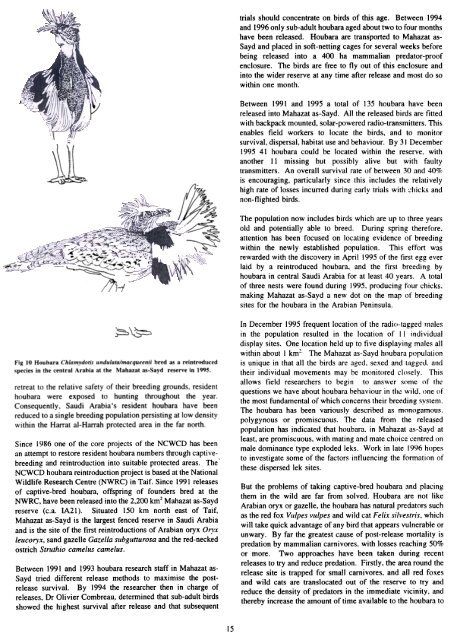Reintroduction of Houbara Bustards into Central ... - Nwrc.gov.sa
Reintroduction of Houbara Bustards into Central ... - Nwrc.gov.sa
Reintroduction of Houbara Bustards into Central ... - Nwrc.gov.sa
You also want an ePaper? Increase the reach of your titles
YUMPU automatically turns print PDFs into web optimized ePapers that Google loves.
trials should concentrate on birds <strong>of</strong> this age. Between 1994and 1996 only sub-adult houbara aged about two to four monthshave been released. <strong>Houbara</strong> are transported to Mahazat as-Sayd and placed in s<strong>of</strong>t-netting cages for several weeks beforebeing released <strong>into</strong> a 400 ha mammalian predator-pro<strong>of</strong>enclosure. The birds are free to fly out <strong>of</strong> this enclosure and<strong>into</strong> the wider reserve at any time after release and most do sowithin one month.~!;":'.~~.;,..,. -4: .J-~--~ '~../'- ~. ~:.'1:'";~~/:.. \ "' ~"'\/-;; ,~ ;.,.-~-..1..:::-:-1iJ-1a- TheBetween 1991 and 1995 a total <strong>of</strong> 135 houbara have beenreleased <strong>into</strong> Mahazat as-Sayd. All the released birds are fittedwith backpack mounted, solar-powered radio-transmitters. Thisenables field workers to locate the birds, and to monitorsurvival, disper<strong>sa</strong>l, habitat use and behaviour. By 31 December1995 41 houbara could be located within the reserve, withanother 11 missing but possibly alive but with faultytransmitters. An overall survival rate <strong>of</strong> between 30 and 40171f,is encouraging, particularly since this includes the relativelyhigh rate <strong>of</strong> losses incurred during early trials with chicks andnon-flighted birds.population now includes birds which are up to three yearsold and potentially able to breed. During spring therefore,attention has been focused on locating evidence <strong>of</strong> breedingwithin the newly established population. This effort wasrewarded with the discovery in April 1995 <strong>of</strong> the first egg everlaid by a reintroduced houbara, and the first breeding byhoubara in central Saudi Arabia for at least 40 years. A total<strong>of</strong> three nests were found during 1995, producing four chicks,making Mahazat as-Sayd a new dot on the map <strong>of</strong> breedingsites for the houbara in the Arabian Peninsula.Fig 10 Houhara Chlamydotis undulata/macqueenii hred as a reintroducedspecies in the central Arahia at the Mahazat as-Sayd reserve in 1995.retreat to the relative <strong>sa</strong>fety <strong>of</strong> their breeding grounds, resident~~houbara were exposed to hunting throughout the year .Consequently, Saudi Arabia's resident houbara have beenreduced to a single breeding populationpersisting at low densitywithin the Harrat al-Harrah protected area in the far north.Since 1986 one <strong>of</strong> the core projects <strong>of</strong> the NCWCDhas beenan attempt to restore resident houbara numbers through captivebreedingand reintroduction<strong>into</strong> suitable protected areas. TheNCWCD houbara reintroduction project is based at the NationalWildlife Research Centre (NWRC) in Taif. Since 1991 releases<strong>of</strong> captive-bred houbara. <strong>of</strong>fspring <strong>of</strong> founders bred at theNWRC, have been released <strong>into</strong> the 2.200 km2 Mahazat as-Saydreserve (c.a. IA21). Situated 150 km north east <strong>of</strong> Taif.Mahazat as-Sayd is the largest fenced reserve in Saudi Arabiaand is the site <strong>of</strong> the first reintroductions<strong>of</strong> Arabian oryx Oryx/euc<strong>of</strong>")'x. <strong>sa</strong>nd gazelle Gaze/la sub gut tu ro<strong>sa</strong> and the red-neckedostrich StruthioBetweencame/us came/us.1991 and 1993 houbara research staff in Mahazat as-Sayd tried different release methods to maximise the postreleasesurvival. By 1994 the researcher then in charge <strong>of</strong>releases. Dr Olivier Combreau. determined that sub-adult birdsshowed the highest survivalafter release and that subsequentIn December 1995 frequent location <strong>of</strong> the radio-tagged malesin the population resulted in the location <strong>of</strong> II individualdisplay sites. One location held up to five displaying males allwithin about I kmL The Mahazat as-Sayd houbara populationis unique in that all the birds are aged, sexed and tagg('d. andtheir individual movements may be monitored cl(lsely. Thi<strong>sa</strong>llows field researchers to begin to answer sl1me <strong>of</strong> thequestions we have about houbara behaviour in tile wild, one <strong>of</strong>the most fundamental <strong>of</strong> which concerns their breeding s~.stem.The houbara has been variously described as monogamous.polygynous or promiscuous. The data from the releasedpopulation has indicated that houbara. in Mahazat as-Sayd atleast, are promiscuous, with mating and mate choice centred onmale dominance type exploded leks. Work in late 1996 hopesto investigate some <strong>of</strong> the factors influencing the formation <strong>of</strong>these dispersed lek sites.But the problems <strong>of</strong> taking captive-bred houbara and placingthem in the wild are far from solved. <strong>Houbara</strong> are not likeArabian oryx or gazelle, the houbara has natural predators suchas the red fox Vulpes vulpes and wild cat Felix .\"ilvestri.\", whichwill take quick advantage <strong>of</strong> any bird that appears vulnerable orunwary .By far the greatest cause <strong>of</strong> post-release mortality ispredation by mammalian carnivores. with losses reaching 50%or more. Two approaches have been taken during recentreleases to try and reduce predation. Firstly, the area round therelease site is trapped for small carnivores, and all red fo)(e<strong>sa</strong>nd wild cats are translocated out <strong>of</strong> the reserve to try andreduce the density <strong>of</strong> predators in the immediate vicinity. andthereby increase the amount <strong>of</strong> time available to the houbara to15
















